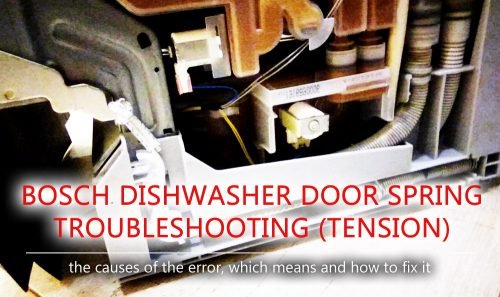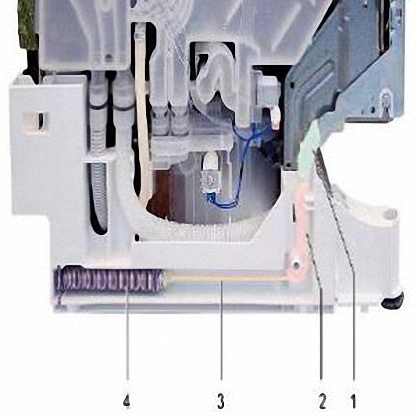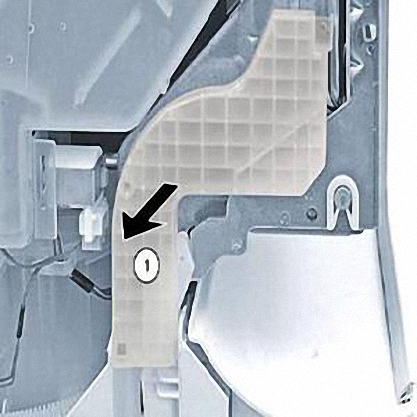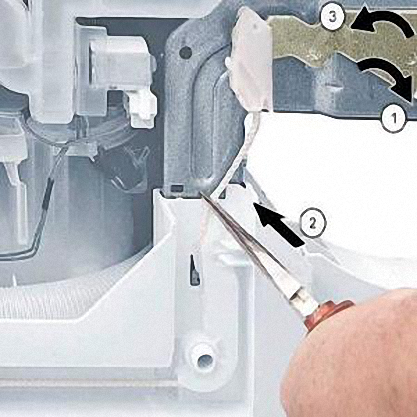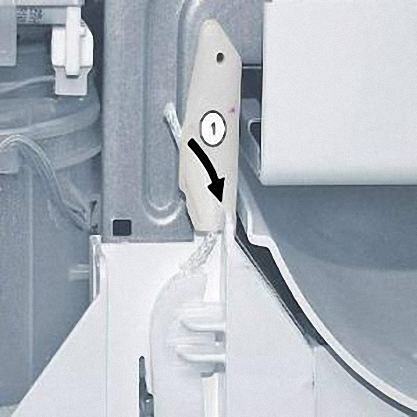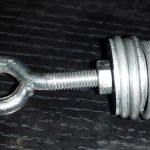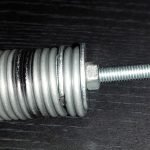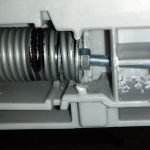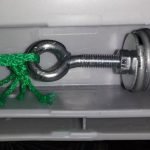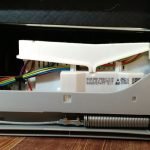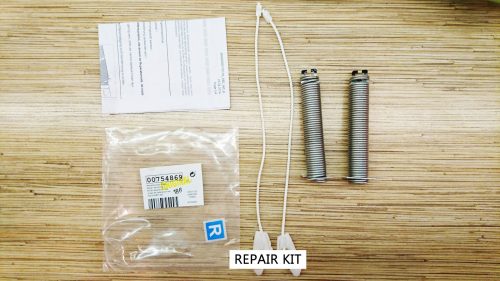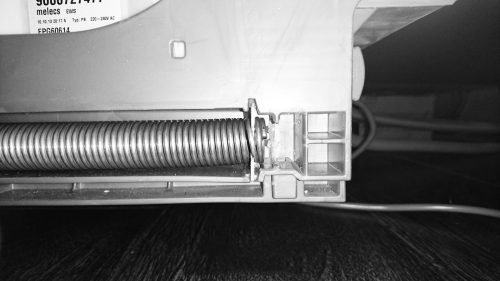The most common problem is associated with the door breakage. Trying to open the door, it falls into the open wide position under the action of the gravitational force. With such clumsy actions, the door can get additional damage, so it must be held while opening. The bad thing is that with such breakage, the door cannot be left slightly opened to allow the washing chamber to dry after the program is finished.
Therefore, it leads to the formation of mold inside and the destruction of rubber gaskets.
How to identify the problem?
- First, completely disconnect the dishwasher from all units and pull out all niche in which the device was installed. Do not remove the facade of the door.
- Some models are equipped with side walls that have to be removed.
- Come to the dishwasher side and look at the bottom of the body. There is a groove with a spring inside, a cable and plastic adapters.
Most of all, such situation is caused by the cable tore or the plastic adapter breaking, disconnecting the cable with the spring.
Also, the common problem is the mechanical damage of the springs block. These elements are located on the right and left sides near the pallet. The traction force is transmitted to the door hinge by the draft cable. An example of such scheme is shown in the picture.
The legends: 1 – the draft cable holder, 2 – the lever arm, 3 – the traktor cable, 4 – the door spring.
The sequence of repair activities is the next:
- The sidewall dismantling. It is installed due to the special latches. When removing, it is required to move the surface to the side carefully, so as not to cause damage to the structural elements. When this task is completed, you can see the following situation.
- Pull the lid of the guide cord towards yourself. There will be some resistance by fixing, but you can ignore it. In some cases, there is a grip and if you continue to pull, the fastener will break.
- The entire cable system passes a dismantling procedure. For this purpose, a certain sequence of activities is carried out. This has to be explained more detailed. First, remove the holder and the lever. After that, the cord and the spring can be removed.
Installing a new spring in the Bosch dishwasher
- The cable holder is suspended, as shown in the photo below. Fixe its part in one position using the pliers. It is necessary to prevent any friction against the pallet that occurs during operation.
During operation, the door must be slightly opened to create a tension of the cable.
- The cord has to be firmly fixed with pliers in the set position. When this task is done, the door closes. The cable system is automatically suspended by the door lever.
A few important points that can lead to breakdowns in the future:
- The door springs of the dishwasher are marked with a colored marker on the rear panel of the appliance. This markup is placed on the wall that allows a user to get information about the parameters.
- Only the paired changing is allowed. During operation, the tension coefficient gradually decreases and this leads to a difference in the old door spring.
- When replacing, both springs have to be designated with the same article. This is necessary to ensure an equal coefficient of tension. At the same time, it is not necessary to install the original products (but it is recommended).
- Each spring is color-coded. The right and left products must have the same color.
How to eliminate the door (spring) breakage of the Bosch dishwasher: Methods and useful advice from users
- Remove the spring and cable from the groove so that these parts do not interfere your repair work.
- At the end of the groove from the back wall, drill a hole for the bolt. The length of the bolt has to be 5 cm.
- Retreat from the edge of the spring three turns and insert a shim with wide margins.
- From the back of the spring, insert the bolt so that it passes through the shim inserted into the spring. The bolt thread should almost completely come out of the spring.
- Put a shim on the thread, and then rotate the screw-nut, firmly connecting the bolt with the spring. Tighten tightly so that the washers do not move to the right and left.
- Take the end of the cable that leads to the spring, put a shim and the screw-nut on it. Tie the end of the cable with a knot so that the screw-nut and the shim do not slip off. Instead of these details, you can use a steel wire hook, but in this case, the connection will not be so reliable.
- Carefully round off three coil springs on the opposite side.
- Insert the shim with a cord between loops and tighten them properly.
- Thus, the spring was connected to the cable, and a long thread emerges from it at the other end.
- Put the spring with the cable in the groove, and thread the pin into the drilled hole.
- Put on a shim with wide margins on the carving, and rotate the screw-nut, firmly fixing the spring in the groove.
So what have we got? The spring is firmly applied to the groove, and the cable is securely attached to it, too. To break such connection, you will have, as a minimum, to break a strong cable that consists of a synthetic fiber. Actually, it is very difficult. Check how the door opens and closes, and, if everything is OK, collect the kitchen appliance and connect it to the mains.

